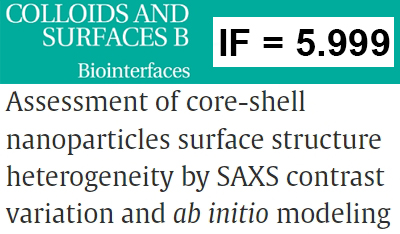Press-room / news / Science news /
Assessment of core-shell nanoparticles surface structure heterogeneity by SAXS contrast variation and ab initio modeling
A group of scientists from the Laboratory of Molecular Biophysics and the Laboratory of Carbohydrates of the IBH RAS in collaboration with colleagues from the A.V. Shubnikov Institute of Crystallography of the Russian Academy of Sciences and the European Molecular Biology Laboratory (Hamburg) has developed a new approach to the study of the structure of nanoparticles, combining the methods of SAXS and molecular dynamics.

For the biomedical applications of nanoparticles, the study of their structure is a major step towards understanding the mechanisms of their interaction with biological environment. Detailed structural analysis of particles' surface is vital for rational design of drug delivery systems. In particular, for core-shell or surface-modified nanoparticles surface structure can be described in terms of shell coating uniformity and shell thickness uniformity around the nanoparticle core. Taken together, these terms can be used to indicate degree of heterogeneity of nanoparticle surface structure. However, characterization of nanoparticle surface structure under physiological conditions is challenging due to limitations of experimental techniques. In this paper, we apply SAXS contrast variation combined with ab initio bead modeling for this purpose. Approach is based on the fact that nanoparticles under study are produced by self- assembly of phospholipid-conjugated molecules that possess moieties with significantly different electron densities enabling SAXS technique to be used to distinguish nanoparticle shell and study its structure. Ab initio single phase and ab initio multiphase modeling based on SAXS curve of nanoparticles in phosphate buffer solution allowed to reconstruct nanoparticle shell coating and assess its uniformity, while serial nanoparticle reconstructions from solutions with gradually increased solvent electron densities revealed relative shell coating thickness around nanoparticle core. Nanoparticle shell structure representation was verified by molecular dynamics simulation and derived full-atom nanoparticle shell structure showed good agreement with SAXS-derived representation. In this paper, we have applied a combination of SAXS contrast variation on the one hand, and low-resolution Ab initio single- and multiphase structure restoration on the other, to characterize the surface structure of core-shell nanoparticles formed by biotin-CMG2-DOPE amphiphil. This approach allows us to demonstrate heterogeneity of the nanoparticles surface consisting in a non-uniform distribution of the polar CMG2 spacer around the nonpolar core, and its preferential localization in the form of patches. The data were verified by comparison with all-atom nanoparticle structure obtained from molecular dynamics simulation. These results were found to be in good agreement suggesting that SAXS contrast variation is a suitable technique for qualitative assessment of surface structure heterogeneity of multi-phase nanoparticles that are formed by constituents that have different electron density.
The results are published in Colloids and Surfaces B: Biointerfaces.
february 24, 2023


